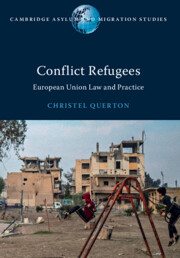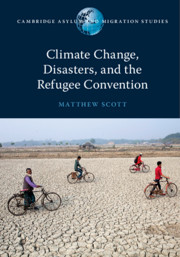16 results

Refugee Policies in East Asia
-
- Published online:
- 14 January 2025
- Print publication:
- 30 January 2025
-
- Element
- Export citation
1 - Introduction
-
- Book:
- Judging Refugees
- Published online:
- 15 March 2024
- Print publication:
- 28 March 2024, pp 1-22
-
- Chapter
- Export citation
3 - How Did We Get Here? A History of the Oral Hearing in Australia and Canada
-
- Book:
- Judging Refugees
- Published online:
- 15 March 2024
- Print publication:
- 28 March 2024, pp 40-65
-
- Chapter
- Export citation
7 - Beyond the Demand for Narrative: Genres of Refugee Testimony
-
- Book:
- Judging Refugees
- Published online:
- 15 March 2024
- Print publication:
- 28 March 2024, pp 136-153
-
- Chapter
- Export citation
8 - Conclusion
-
- Book:
- Judging Refugees
- Published online:
- 15 March 2024
- Print publication:
- 28 March 2024, pp 154-160
-
- Chapter
- Export citation
2 - Law, Literature and Narrative in the RSD Oral Hearing
-
- Book:
- Judging Refugees
- Published online:
- 15 March 2024
- Print publication:
- 28 March 2024, pp 23-39
-
- Chapter
- Export citation
6 - ‘I’ll Just Stop You There’: Fragmentation of Refugees’ Oral Testimony
-
- Book:
- Judging Refugees
- Published online:
- 15 March 2024
- Print publication:
- 28 March 2024, pp 113-135
-
- Chapter
- Export citation

Judging Refugees
- Narrative and Oral Testimony in Refugee Status Determination
-
- Published online:
- 15 March 2024
- Print publication:
- 28 March 2024
1 - Introduction
-
- Book:
- Conflict Refugees
- Published online:
- 20 July 2023
- Print publication:
- 10 August 2023, pp 1-17
-
- Chapter
- Export citation

Conflict Refugees
- European Union Law and Practice
-
- Published online:
- 20 July 2023
- Print publication:
- 10 August 2023
6 - Singled Out
- from Part I - Tracing ‘Discretion’ Reasoning
-
- Book:
- The Concealment Controversy
- Published online:
- 19 July 2021
- Print publication:
- 29 July 2021, pp 128-162
-
- Chapter
- Export citation
5 - Irreversibly Determined
- from Part I - Tracing ‘Discretion’ Reasoning
-
- Book:
- The Concealment Controversy
- Published online:
- 19 July 2021
- Print publication:
- 29 July 2021, pp 103-127
-
- Chapter
- Export citation
4 - Manifestly Asserted
- from Part I - Tracing ‘Discretion’ Reasoning
-
- Book:
- The Concealment Controversy
- Published online:
- 19 July 2021
- Print publication:
- 29 July 2021, pp 79-102
-
- Chapter
- Export citation

The Concealment Controversy
- Sexual Orientation, Discretion Reasoning and the Scope of Refugee Protection
-
- Published online:
- 19 July 2021
- Print publication:
- 29 July 2021
1 - Introduction
-
- Book:
- Climate Change, Disasters, and the Refugee Convention
- Published online:
- 18 January 2020
- Print publication:
- 06 February 2020, pp 1-9
-
- Chapter
- Export citation

Climate Change, Disasters, and the Refugee Convention
-
- Published online:
- 18 January 2020
- Print publication:
- 06 February 2020

